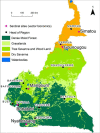High vector diversity and malaria transmission dynamics in five sentinel sites in Cameroon
- PMID: 37055836
- PMCID: PMC10100606
- DOI: 10.1186/s12936-023-04552-z
High vector diversity and malaria transmission dynamics in five sentinel sites in Cameroon
Abstract
Background: Malaria remains one of the main causes of morbidity and mortality in Cameroon. To inform vector control intervention decision making, malaria vector surveillance was conducted monthly from October 2018 to September 2020 in five selected sentinel sites (Gounougou and Simatou in the North, and Bonabéri, Mangoum and Nyabessang in the South).
Methods: Human landing catches (HLCs), U.S. Centers for Disease Control and Prevention (CDC) light traps, and pyrethrum spray catches (PSCs) were used to assess vector density, species composition, human biting rate (HBR), endophagic index, indoor resting density (IRD), parity, sporozoite infection rates, entomological inoculation rate (EIR), and Anopheles vectorial capacity.
Results: A total of 139,322 Anopheles mosquitoes from 18 species (or 21 including identified sub-species) were collected across all sites. Out of the 18 species, 12 were malaria vectors including Anopheles gambiae sensu lato (s.l.), Anopheles funestus s.l.., Anopheles nili, Anopheles moucheti, Anopheles paludis, Anopheles demeilloni, Anopheles. pharoensis, Anopheles ziemanni, Anopheles multicinctus, Anopheles tenebrosus, Anopheles rufipes, and Anopheles marshallii. Anopheles gambiae s.l. remains the major malaria vector (71% of the total Anopheles) collected, though An. moucheti and An. paludis had the highest sporozoite rates in Nyabessang. The mean indoor HBR of Anopheles ranged from 11.0 bites/human/night (b/h/n) in Bonabéri to 104.0 b/h/n in Simatou, while outdoors, it varied from 24.2 b/h/n in Mangoum to 98.7 b/h/n in Simatou. Anopheles gambiae s.l. and An. moucheti were actively biting until at least 8:00 a.m. The mean Anopheles IRD was 17.1 females/room, and the parity rate was 68.9%. The mean EIRs for each site were 55.4 infective bites/human/month (ib/h/m) in Gounougou, 99.0 ib/h/m in Simatou, 51.2 ib/h/m in Mangoum, 24.4 ib/h/m in Nyabessang, and 18.1 ib/h/m in Bonabéri. Anopheles gambiae s.l. was confirmed as the main malaria vector with the highest vectorial capacity in all sites based on sporozoite rate, except in Nyabessang.
Conclusion: These findings highlight the high malaria transmission occurring in Cameroon and will support the National Malaria Control Program to design evidence-based malaria vector control strategies, and deployment of effective and integrated vector control interventions to reduce malaria transmission and burden in Cameroon, where several Anopheles species could potentially maintain year-round transmission.
Keywords: Cameroon; Malaria transmission; Vector diversity; Vectorial capacity.
© 2023. The Author(s).
Conflict of interest statement
The authors declare no competing interests. The findings and conclusions expressed herein are those of the authors and do not necessarily represent the official position of USAID, PMI, nor the U.S. Centers for Disease Control and Prevention (CDC).
Figures



References
-
- NMCP. Cameroon National Malaria Control Programme annual report. Yaoundé, Cameroon, 2019.
-
- NMCP. Cameroon National Malaria Control Programme annual report. Yaoundé, Cameroon, 2020.
-
- WHO . World malaria report 2020. Geneva: World Health Organization; 2020.
-
- WHO . World malaria report 2021. Geneva: World Health Organization; 2021.
MeSH terms
Substances
LinkOut - more resources
Full Text Sources
Medical

